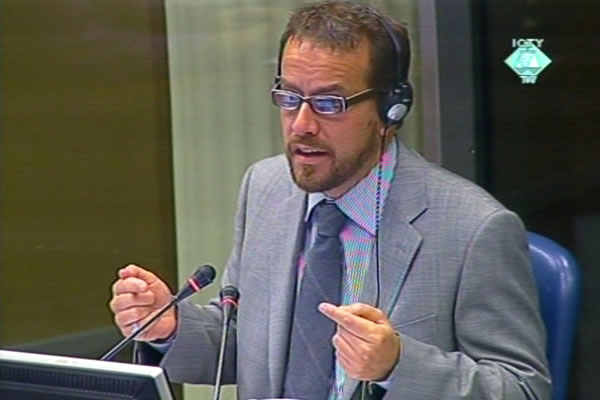Home
ANTHROPOLOGICAL EVIDENCE FROM MASS GRAVES
Jose Baraybar, forensic anthropologist from Peru, testified at the trial of Radovan Karadzic. Baraybar explained the procedure and methodology he used to establish the number, age, sex and cause of death of the victims exhumed from Srebrenica mass graves
 Jose Baraybar, witness at the Radovan Karadzic trial
Jose Baraybar, witness at the Radovan Karadzic trial Forensic anthropologist from Peru Jose Baraybar testified at the trial of former Republika Srpska president Radovan Karadzic. Baraybar was in charge of the exhumations from the mass graves in the Srebrenica area, in Nova Kasaba, Konjevic Polje and Glogova. Karadzic is on trial for genocide and other crimes in BH.
In the examination-in chief, two expert reports the witness wrote about the anthropological analysis of the remains and the exhumations of mass graves in eastern Bosnia in 1999 were admitted into evidence together with the transcripts of the witness’s testimony at the trial of Radislav Krstic in May 2000. The witness also testified at the Popovic et al. trial and Tolimir’s trials.
According to the summary read out by the prosecutor, at the Krstic trial the witness explained in detail the procedure and methodology used to determine the number, age and sex of the exhumed victims as well as the cause of their deaths. Based on an analysis of the remains exhumed until 2001, the witness estimated that at least 2,541 persons had been buried in the mass graves found until that time.
Baraybar explained that he had counted the bones of the same type among the exhumed body parts, such as skulls, and arm and leg bones, to obtain the minimal number of individuals. Baraybar emphasized that the effort to determine the minimal number of individuals was thwarted by the fact that the bodies had been transferred from primary to secondary graves.
In the cross-examination Karadzic claimed that eastern Bosnia was ‘a battlefield where people were killed on a daily basis in the 42 months of the civil war’. Karadzic put it to the witness that an analysis of the mortal remains couldn’t be used to establish if the victims died before, during or after the operation to seize Srebrenica.
The witness agreed, but added that the supplementary evidence could be used to establish when a person was killed. For example, this could be done by comparing the information from personal documents and other evidence such as the lists put together by the International Red Cross which indicate that a person was last seen in Srebrenica in July 1995. ‘Unless proven otherwise, my logical conclusion is that victims carrying identity cards whose names are on the International Red Cross list died after July 1995’, the witness said.
After the witness noted that he hadn’t seen any victims in military uniforms exhumed from mass graves, Karadzic said ‘nobody was crazy enough’ to bury dead soldiers with their weapons and equipment. As Karadzic went on to explain, many soldiers wore civilian clothes, adding that the first thing fighters fleeing from their enemy did was to change into civilians clothes. Although he noted this was not his area of expertise, the witness said he simply couldn’t imagine someone running away from their enemy changing their clothes as they ran.
Radovan Karadzic’s trial continues on Monday morning with the evidence of American expert on Ottoman cultural heritage Andras Riedlmayer.
Linked Reports
- Case : Karadzic
- 2011-12-01 EVIDENCE FROM MASS GRAVES
- 2011-11-30 WITNESS: EVERYTHING WAS ORGANIZED IN SREBRENICA
- 2011-11-29 THE DUTCH LOST IN TRANSLATION
- 2011-12-08 FIGHTERS WITH BLINDFOLDS AND THEIR HANDS TIED
- 2011-12-09 DESTROYING CULTURAL HERITAGE
- 2012-01-10 SURVIVOR FROM PETKOVCI DAM GIVES EVIDENCE
